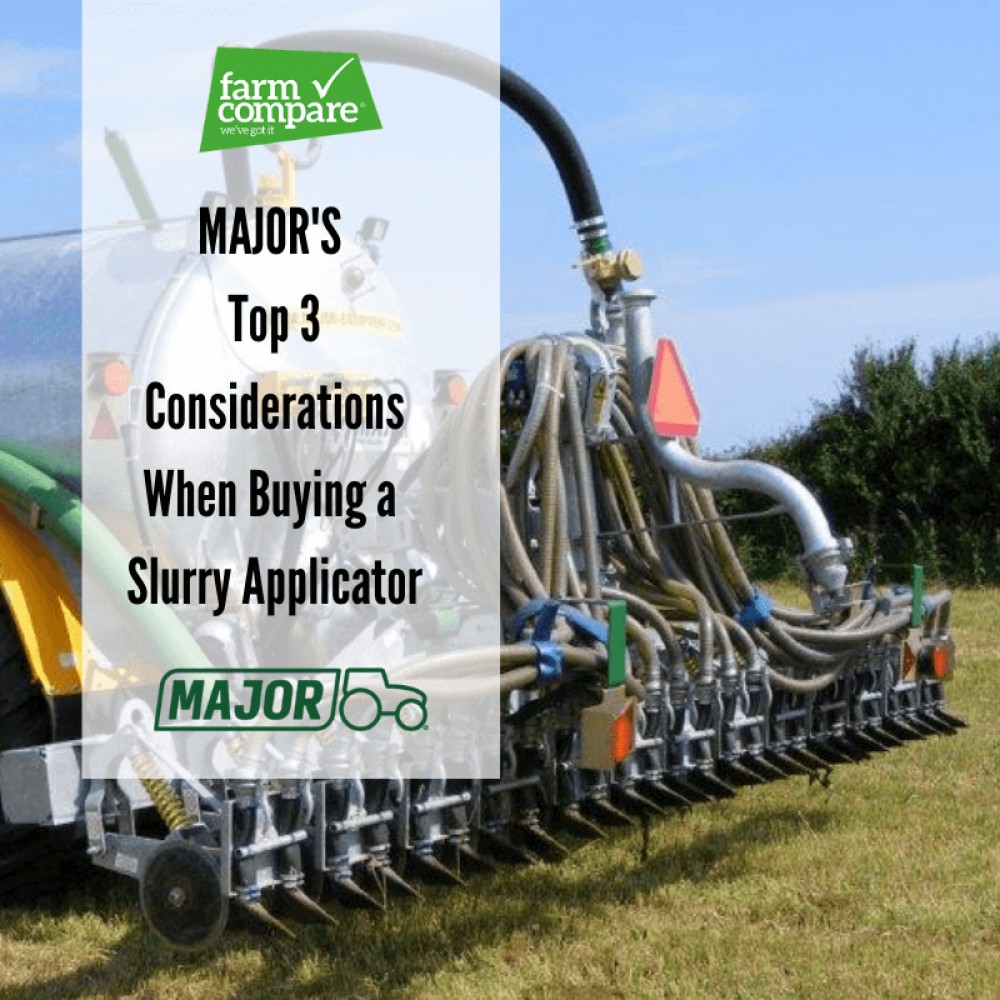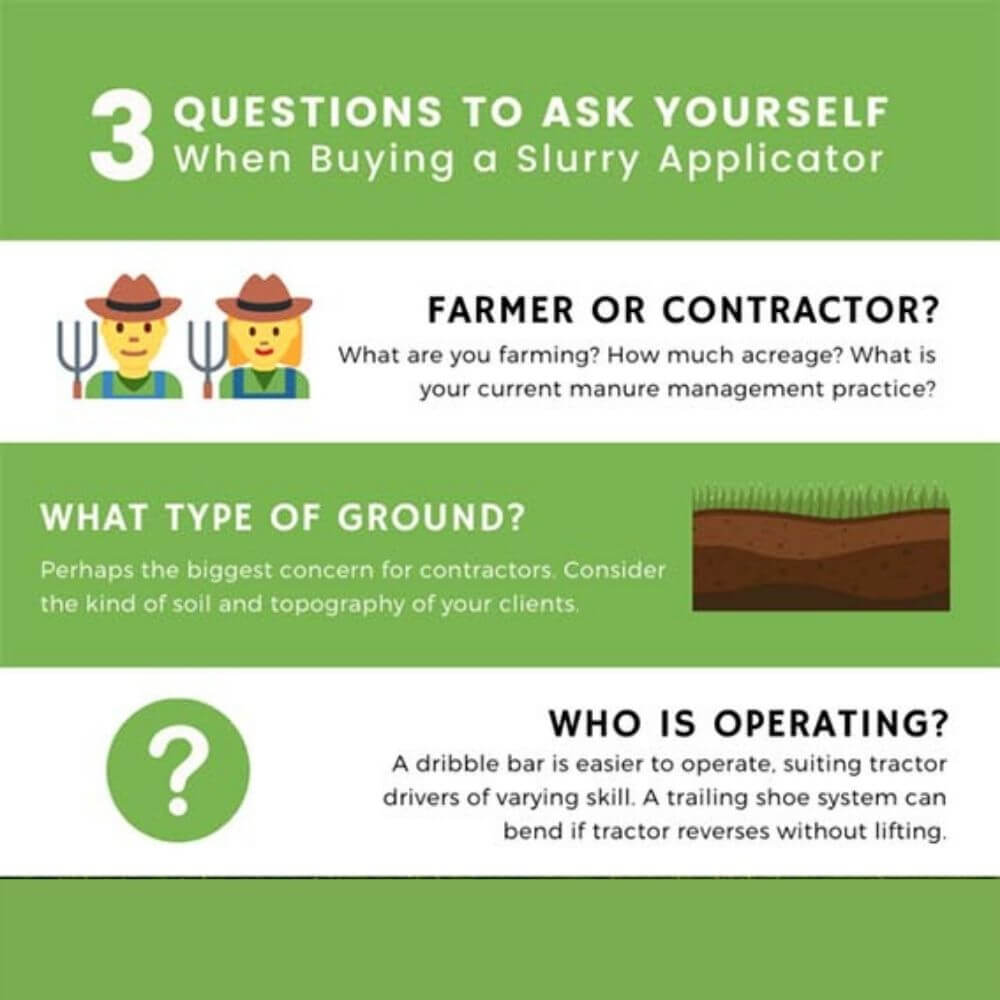MAJOR's guide to buying slurry equipment

Farm Compare is all about finding the right product for you and your farm.
When it comes to slurry application Farm Compare takes advice from slurry machinery specialist MAJOR.
Firstly, let's get the jargon out of the way
Dribble bar, band spreader, trailing hose, trailing shoe, disc injector, or shallow injection? Whatever name you read or see, they all refer to low emission spreading systems under evolving environmental regulations. The variety of systems available, and the number of options and features, can be baffling to even the most experienced farmer!
MAJOR have put together the top 3 questions to ask yourself when considering a new slurry applicator. They understand every farm operates differently, so there is no one-size-fits-all approach. But, thinking carefully about these elements will help determine a solution that best fits you.

1. Farmer or contractor or both?
This is the first question MAJOR ask when talking about slurry applicators. For farmers to extract the most out of the slurry while staying compliant with emissions regulations, MAJOR also wants to understand your farming conditions including livestock, acreage, and current manure management practices.
For example, Michael Canny single-handedly runs a high-yielding herd of Holstein Friesians and followers on 200-acres in Co. Galway. Soil type is heavy clay and grass crops are heavy in this part of the country. He employs a traditional grazing system plus a zero-grazing regime sourced from between 40 and 60 acres on the farm, depending on yield. All waste and slurries are collected into a 200,000-gallon overhead lagoon system.
He uses a 3500-gallon Tandem Major tanker with a 7m trailing shoe applicator to spread slurry back to the pastures. The trailing shoe applies slurry at the soil surface minimising sward contamination. Not only does this reduce ammonia emissions by 65% compared with 35% using the dribble bar (Note 1) but this method also improves grass yields by 21%, compared to 19% using the dribble bar. It also means stock can return back to land more quickly.
The precise time is dependent on a number of variables including rotation schedules, weather, and ground conditions but stock can return to grazing as early as two weeks after application by trailing shoe compared with splash plate application.
He can spread slurry back onto the grazed and zero-grazed pastures throughout the year. In general, he can give three or four applications at about 2,000-gallons per acre.
When you’re running a tight operation and trying to keep fertiliser costs to a minimum, these are significant savings in the long run.
2. What kind of ground?
Ground-type should be the biggest concern for contractors. The kind of soil and topography of your clients will determine which system to choose. If the area is hilly and wet very often then a dribble bar will do just fine. You can still reduce ammonia emissions by 35% and improve grass yields by 19% (Note 1) (see chart).
The dribble bar system works well on both grassland and arable crop while trailing shoe is often better suited for grassland. The trailing shoe is optimal to apply slurry in heavy clay soil and works well in grass longer than 8cm in height.
Disc injector or shallow injection has discs that cut into the ground surface and hoses deposit slurry directly into the slits. This is the best method of reducing ammonia losses with 99% reduction rate. It’s also best for retaining nutrients: 11 units of Nitrogen per 1000 gallons of slurry compared to 3 units of Nitrogen per 1000 gallons using a splash plate (Note 2). This translates to a 25% improvement in grass yields.
However, a pitfall of shallow injection is it may not suit all soil types. Soil texture, stone content, and ground contours limits its use. Also, this system requires greater tractor power to pull the discs through the ground. Disc injectors work best on short swards and place slurry 5-6cm below the surface.
3. Who is operating?
Another thing contractors (or anyone really) should acknowledge the tractor driver. Contractors taking bookings from stressed out farmers with high covers might enlist extra help. The dribble bar is easier to operate so you’ve little to fear if you have a 17-year-old at the tractor wheel. If you reverse the tractor and forget to lift, you’ll bend the trailing shoe and pay a few hundred quid to repair the damage. But with a dribble bar it’s not a worry.
The effectiveness of each technique will depend on slurry characteristics, application rates, and weather conditions. For example, the trailing shoe method performs better if used following some grass growth, such as springtime application, rather than immediately on silage or grazing aftermath. Slurry injection under hot, dry conditions can cause grass scorching.
Benefits of using low emission slurry spreaders
► Reduced chemical fertiliser inputs
► ReduCed odour
► Reduced sward contamination
► More flexibility in rate & timing of slurry application
► Increase of grass yield
► Better uniformity of application
There are plenty of other factors to consider including macerator, work rate, and maintenance costs but these three areas should serve as the beginning point to decide which system best suits your operation. The chart compares the three most popular systems on the market and their advantages (see below).
.jpg)
View the MAJOR slurry range on Farm Compare and connect with their Product Specialist to discuss your slurry solution.
Notes:
1. Webb, J., Pain, B., Bittman, S., Morgan, J., (2010), ‘The impacts of manure application methods on emissions of ammonia, nitrous oxide and on crop response—A review’, Agriculture, Ecosystems, and Environment, Volume 137, Issues 1-2, 15 April 2010, Pages 39-46. (https://www.afbini.gov.uk/publications)
2. Teagasc. https://www.teagasc.ie/media/website/publications/2019/11.-Low-Emission-Slurry-Spreaders.pdf
© 2026 Farm Compare Ltd. All rights reserved| T&Cs | Privacy policy | Website by Reflex Studios

This website was developed with support from Priority 6 (LEADER) of the Northern Ireland Rural Development Programme 2014-2020 by the Department of Agriculture, Environment and Rural Affairs and the European Agricultural Fund for Rural Development: Europe investing in rural areas

